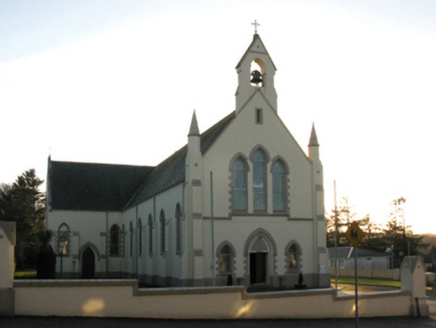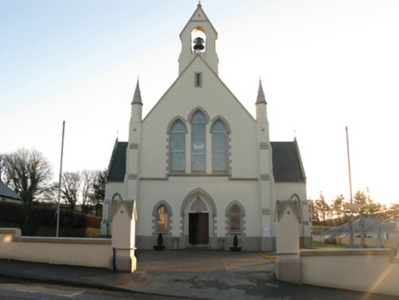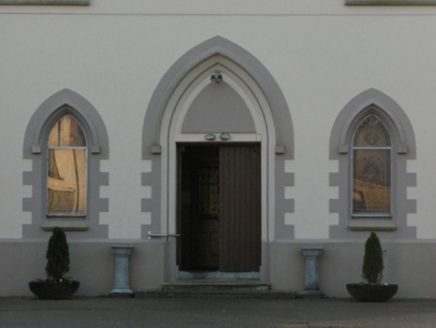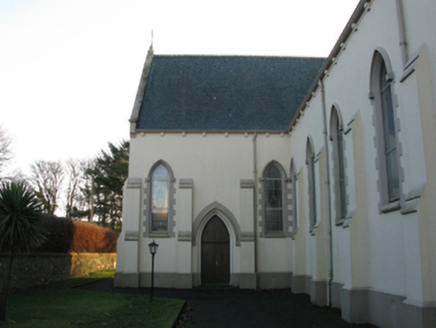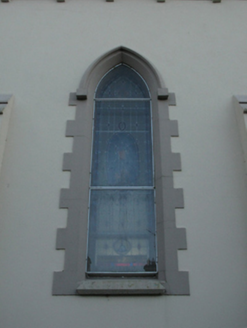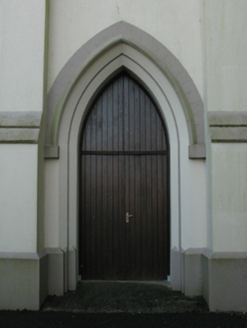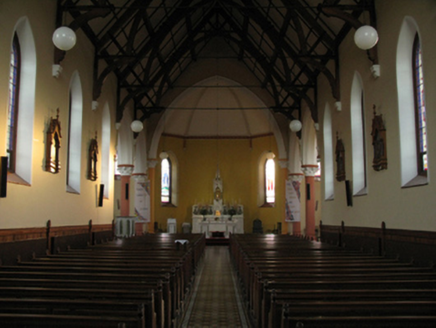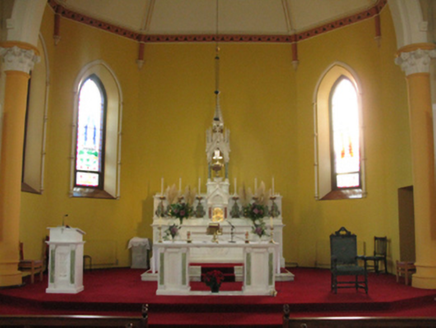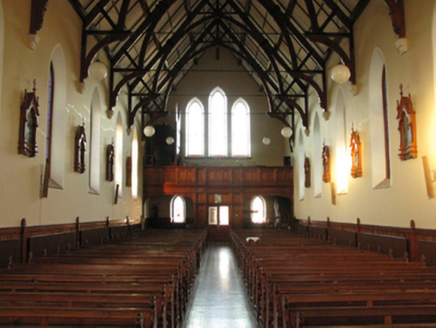Survey Data
Reg No
31201005
Rating
Regional
Categories of Special Interest
Architectural, Artistic, Historical, Social, Technical
Original Use
Church/chapel
In Use As
Church/chapel
Date
1925 - 1935
Coordinates
110753, 337544
Date Recorded
31/01/2011
Date Updated
--/--/--
Description
Detached eight-bay double-height Catholic church, designed 1930-3; built 1931-3; dedicated 1933, on a cruciform plan comprising six-bay double-height nave opening into single-bay (three-bay deep) double-height transepts centred on single-bay double-height apse to crossing (south) on a half-octagonal plan. Renovated, 1970, with sanctuary reordered. Pitched slate roof on a cruciform plan centred on half-octagonal slate roof (south) with perforated crested clay ridge tiles, concrete coping to gables on "Cavetto" kneelers with "Fleur-de-Lys"-detailed wrought iron Cross finials to apexes including concrete coping to gable to entrance (north) front with rendered, ruled and lined buttressed gabled bellcote to apex framing embossed cast-bronze bell (1932), and cast-iron rainwater goods on "Cavetto" consoles retaining cast-iron downpipes. Rendered walls on rendered chamfered plinth with rendered stepped buttresses having "slated" coping including rendered clasping stepped buttresses to corners to entrance (north) front having "slated" coping supporting octagonal pinnacles. Lancet window openings with concrete sills, and rendered block-and-start surrounds having chamfered reveals with hood mouldings over on label stops framing storm glazing over fixed-pane fittings having stained glass margins centred on leaded stained glass panels. Lancet "Trinity Windows" to transepts with concrete sills, and rendered block-and-start surrounds having chamfered reveals with hood mouldings over on label stops framing storm glazing over fixed-pane fittings having stained glass margins centred on leaded stained glass panels. Lancet window openings to apse (south) with concrete sills, and rendered block-and-start surrounds having chamfered reveals with hood mouldings over on label stops framing storm glazing over fixed-pane fittings having stained glass margins centred on leaded stained glass panels. Square-headed door opening to entrance (north) front in pointed-arch recess with step threshold, and rendered block-and-start surround having stepped reveals with hood moulding over on label stops framing timber boarded or tongue-and-groove timber panelled double doors. Lancet flanking window openings with concrete sills, and rendered block-and-start surrounds having chamfered reveals with hood mouldings over on label stops framing storm glazing over fixed-pane fittings having stained glass margins centred on leaded stained glass panels. Lancet "Trinity Window" to gable with concrete sill, and rendered block-and-start surrounds having chamfered reveals with hood mouldings over on label stops framing storm glazing over fixed-pane fittings having stained glass margins centred on leaded stained glass panels. Interior including vestibule (north); square-headed door opening into nave with glazed timber panelled double doors; full-height interior open into roof with timber panelled choir gallery (north) supporting timber pipe organ below stained glass "Trinity Window" (2000), tiled central aisle between trefoil-detailed timber pews, Gothic-style timber memorial stations (undated) between stained glass windows (2000), pointed-arch arcades to transepts on Corinthian pillars with hood mouldings over on beaded "Cavetto" label stops, exposed Hammerbeam timber roof construction on beaded "Bowtell" corbels with wind braced ceiling in carved timber frame on carved timber cornice on perforated frieze, and pointed-arch chancel arch framing carpeted stepped dais to sanctuary to crossing (south) reordered, 1970, with pair of stained glass windows (2000) centred on quatrefoil-detailed cut-veined white Carrera marble Gothic-style high altar (1933). Set in landscaped grounds with quatrefoil-detailed rendered piers to perimeter having gabled capping.
Appraisal
A church erected to a design produced (1931-3) by Ralph Henry Byrne (1877-1946) of Suffolk Street, Dublin (DIA), representing an integral component of the twentieth-century built heritage of north County Mayo with the architectural value of the composition, one recalling the Patrick John Fitzgerald Munden (1883-1962)-designed Catholic Church of the Most Holy Rosary (1914-6), Ashford, County Wicklow, confirmed by such traits as the cruciform plan form, aligned along a liturgically-incorrect axis; the slender profile of the openings underpinning a stolid "medieval" Gothic theme; and the handsome bellcote embellishing the roofline as a picturesque eye-catcher in the landscape. Having been well maintained, the elementary form and massing survive intact together with quantities of the original fabric, both to the exterior and to the interior reordered (1970) in accordance with the liturgical reforms sanctioned by the Second Ecumenical Council of the Vatican (1962-5) where timber fittings; and a "flèche"-topped high altar donated by Archdeacon Michael Munnelly (d. 1934), all highlight the artistic potential of the composition: meanwhile, a "medieval" Hammerbeam roof construction pinpoints the engineering or technical dexterity of a church forming part of a neat self-contained group alongside an earlier parochial house (see 31201006) with the resulting ecclesiastical ensemble making a pleasing visual statement in a rural village street scene.
